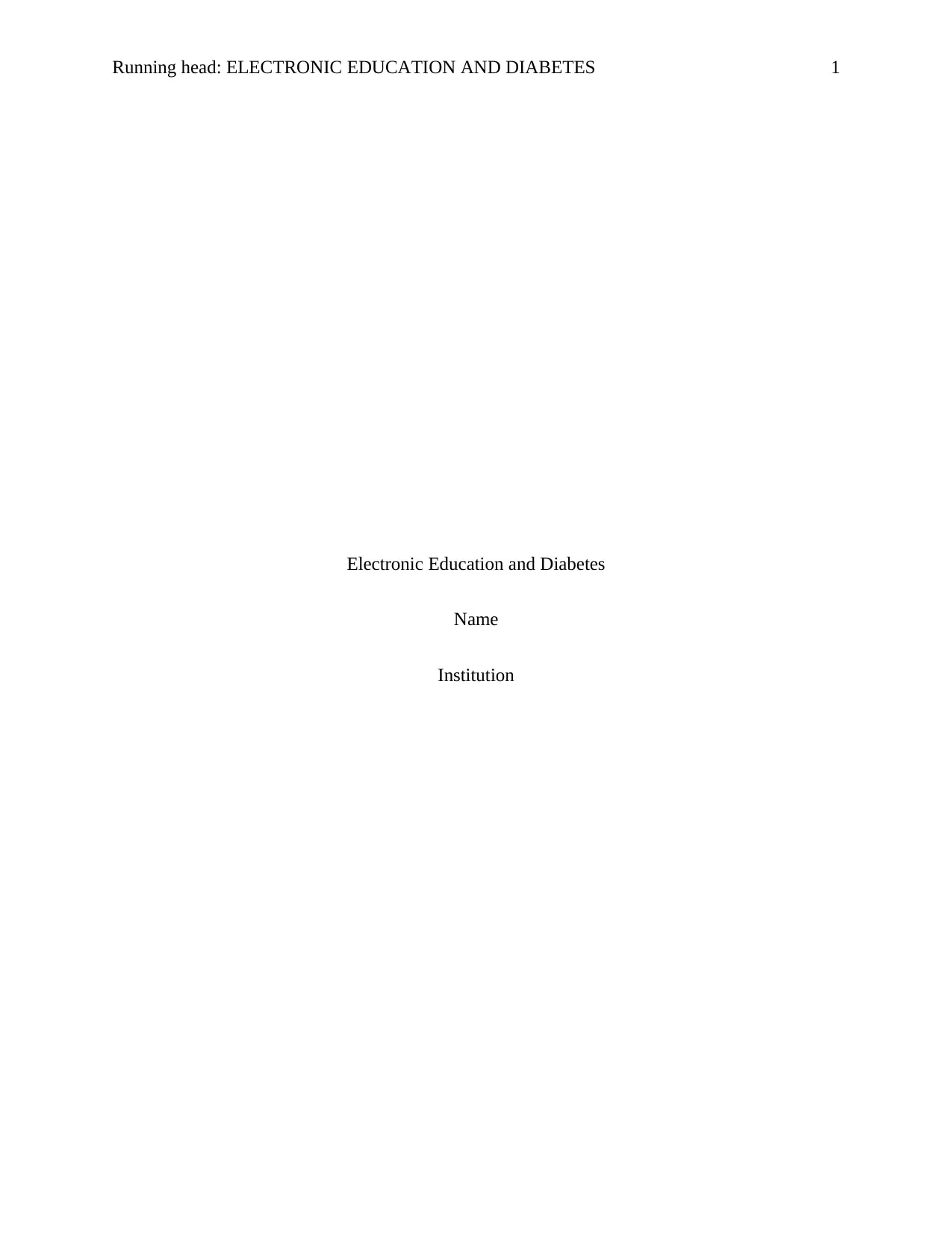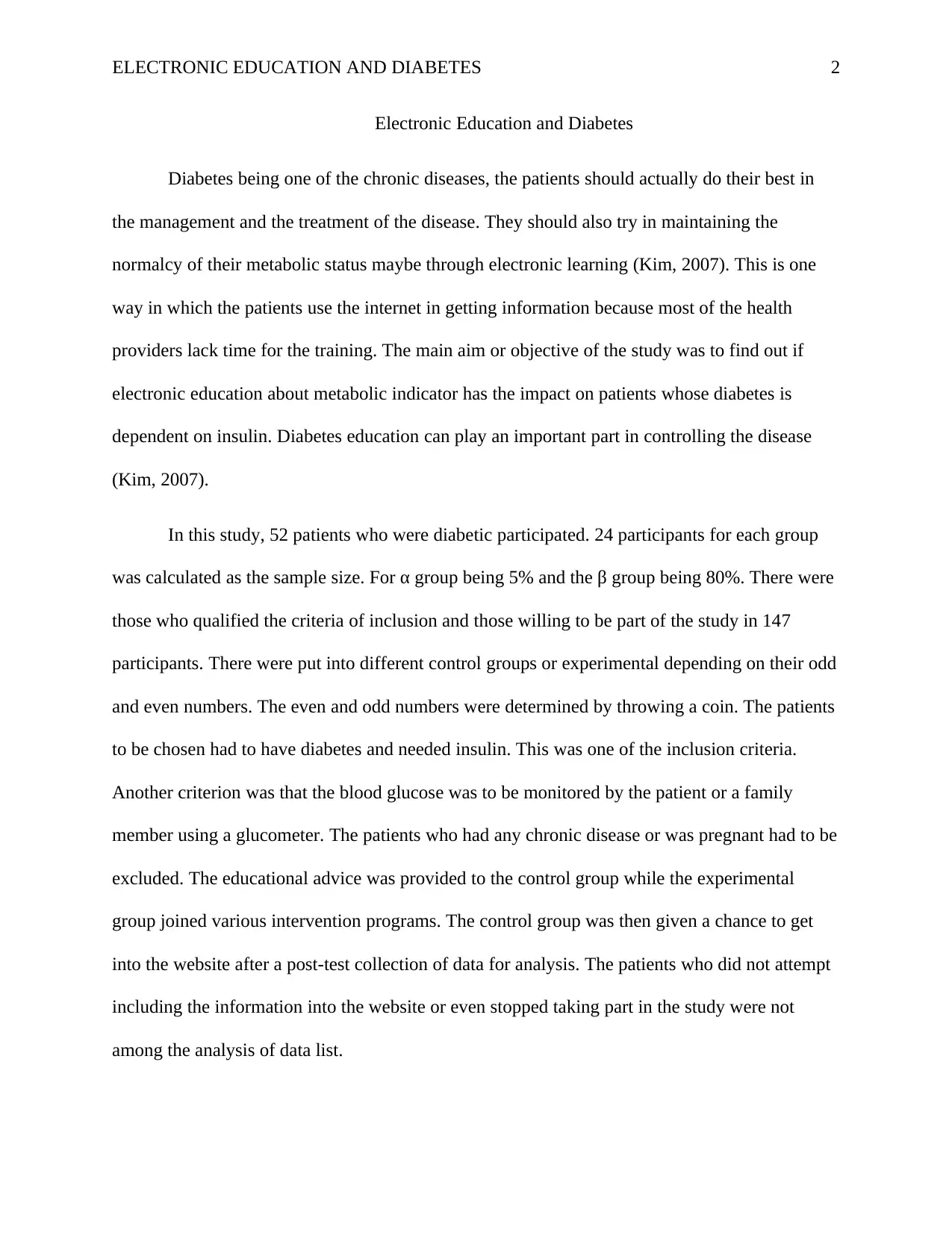Electronic Education and Diabetes: An Analytical Study
VerifiedAdded on 2021/06/17
|5
|912
|228
Report
AI Summary
This report examines the impact of electronic education on diabetes management among patients requiring insulin. The study, involving 52 diabetic participants, explored the effectiveness of online educational interventions compared to a control group receiving standard advice. The experimental group utilized an educational website with interactive features like Q&A sections and personalized data tracking. Results indicated that electronic education led to a significant decrease in HbA1C and LDL levels, and an increase in HDL levels within the experimental group. The report concludes by recommending the use of electronic education for diabetic patients, highlighting its potential to provide timely and comprehensive information, thus enhancing patient outcomes. The study emphasizes the importance of continuous advice and the potential for electronic education to improve patient behavior and health metrics.

Running head: ELECTRONIC EDUCATION AND DIABETES 1
Electronic Education and Diabetes
Name
Institution
Electronic Education and Diabetes
Name
Institution
Paraphrase This Document
Need a fresh take? Get an instant paraphrase of this document with our AI Paraphraser

ELECTRONIC EDUCATION AND DIABETES 2
Electronic Education and Diabetes
Diabetes being one of the chronic diseases, the patients should actually do their best in
the management and the treatment of the disease. They should also try in maintaining the
normalcy of their metabolic status maybe through electronic learning (Kim, 2007). This is one
way in which the patients use the internet in getting information because most of the health
providers lack time for the training. The main aim or objective of the study was to find out if
electronic education about metabolic indicator has the impact on patients whose diabetes is
dependent on insulin. Diabetes education can play an important part in controlling the disease
(Kim, 2007).
In this study, 52 patients who were diabetic participated. 24 participants for each group
was calculated as the sample size. For α group being 5% and the β group being 80%. There were
those who qualified the criteria of inclusion and those willing to be part of the study in 147
participants. There were put into different control groups or experimental depending on their odd
and even numbers. The even and odd numbers were determined by throwing a coin. The patients
to be chosen had to have diabetes and needed insulin. This was one of the inclusion criteria.
Another criterion was that the blood glucose was to be monitored by the patient or a family
member using a glucometer. The patients who had any chronic disease or was pregnant had to be
excluded. The educational advice was provided to the control group while the experimental
group joined various intervention programs. The control group was then given a chance to get
into the website after a post-test collection of data for analysis. The patients who did not attempt
including the information into the website or even stopped taking part in the study were not
among the analysis of data list.
Electronic Education and Diabetes
Diabetes being one of the chronic diseases, the patients should actually do their best in
the management and the treatment of the disease. They should also try in maintaining the
normalcy of their metabolic status maybe through electronic learning (Kim, 2007). This is one
way in which the patients use the internet in getting information because most of the health
providers lack time for the training. The main aim or objective of the study was to find out if
electronic education about metabolic indicator has the impact on patients whose diabetes is
dependent on insulin. Diabetes education can play an important part in controlling the disease
(Kim, 2007).
In this study, 52 patients who were diabetic participated. 24 participants for each group
was calculated as the sample size. For α group being 5% and the β group being 80%. There were
those who qualified the criteria of inclusion and those willing to be part of the study in 147
participants. There were put into different control groups or experimental depending on their odd
and even numbers. The even and odd numbers were determined by throwing a coin. The patients
to be chosen had to have diabetes and needed insulin. This was one of the inclusion criteria.
Another criterion was that the blood glucose was to be monitored by the patient or a family
member using a glucometer. The patients who had any chronic disease or was pregnant had to be
excluded. The educational advice was provided to the control group while the experimental
group joined various intervention programs. The control group was then given a chance to get
into the website after a post-test collection of data for analysis. The patients who did not attempt
including the information into the website or even stopped taking part in the study were not
among the analysis of data list.

ELECTRONIC EDUCATION AND DIABETES 3
Intervention program had an educational site which trained patients who were diabetic.
The site had questions that were frequently asked, educational subjects, educational films, room
for chatting, question and answer section and even a patient’s personal details (Lee et al., 2007).
Before beginning the intervention, the patient or a member of the family was given a way in
which they would access the data. This lasted for almost three hours. On the site was a daily
information which was filled according to the patient’s glucose level, insulin dose, and diabetes
kind. The question-answer section is a platform in which the physician, nurse, and the doctor
provided information and the answers were sent within a span of 24hours. Only the patient and
the healthcare team had that access to the personal details of the patient. The personal details
were then studied and the recommendations send in a week.
Two participants were excluded from the intervention program because of their failure to
enter the data into the website. Two patients from the control group were also excluded because
they were not willing to continue with the study. Type 1 diabetes was found in nearly all the 48
participants. At the beginning of the intervention, mean average HbA1C decreased from 9.10%
to 7.07% for the experimental group. Mean LDL also decreased from 103.04mg/dl to 94.83mg/dl
(Cho et al., 2007). Mean HDL increased from 40mg/dl to 45.48mg/dl. For the control group,
HDL increased but there were no changes in both the LDL and HbA1C (Cho et al., 2007).
Since electronic education leads to a decrease in HbA1C and LDL in patients who are
diabetic and need insulin I recommend the use of it in diabetic patients. Electronic education will
ensure that the patients get the maximum information as opposed to when they visit a doctor.
This I think is one great advantages. I think electrical education, on the other hand, has a
disadvantage in that patients need a timely information so as to affect their behavioral changes.
Intervention program had an educational site which trained patients who were diabetic.
The site had questions that were frequently asked, educational subjects, educational films, room
for chatting, question and answer section and even a patient’s personal details (Lee et al., 2007).
Before beginning the intervention, the patient or a member of the family was given a way in
which they would access the data. This lasted for almost three hours. On the site was a daily
information which was filled according to the patient’s glucose level, insulin dose, and diabetes
kind. The question-answer section is a platform in which the physician, nurse, and the doctor
provided information and the answers were sent within a span of 24hours. Only the patient and
the healthcare team had that access to the personal details of the patient. The personal details
were then studied and the recommendations send in a week.
Two participants were excluded from the intervention program because of their failure to
enter the data into the website. Two patients from the control group were also excluded because
they were not willing to continue with the study. Type 1 diabetes was found in nearly all the 48
participants. At the beginning of the intervention, mean average HbA1C decreased from 9.10%
to 7.07% for the experimental group. Mean LDL also decreased from 103.04mg/dl to 94.83mg/dl
(Cho et al., 2007). Mean HDL increased from 40mg/dl to 45.48mg/dl. For the control group,
HDL increased but there were no changes in both the LDL and HbA1C (Cho et al., 2007).
Since electronic education leads to a decrease in HbA1C and LDL in patients who are
diabetic and need insulin I recommend the use of it in diabetic patients. Electronic education will
ensure that the patients get the maximum information as opposed to when they visit a doctor.
This I think is one great advantages. I think electrical education, on the other hand, has a
disadvantage in that patients need a timely information so as to affect their behavioral changes.
⊘ This is a preview!⊘
Do you want full access?
Subscribe today to unlock all pages.

Trusted by 1+ million students worldwide

ELECTRONIC EDUCATION AND DIABETES 4
Therefore, I think electronic education and continuous advice are highly recommended in
helping patients who are diabetic and need insulin.
Therefore, I think electronic education and continuous advice are highly recommended in
helping patients who are diabetic and need insulin.
Paraphrase This Document
Need a fresh take? Get an instant paraphrase of this document with our AI Paraphraser

ELECTRONIC EDUCATION AND DIABETES 5
References
Cho JH, Chang SA, Kwon HS, Choi YH, Ko SH, Moon SD, Yoo SJ, Song KH, Son HS, Kim
HS, Lee WC, Cha BY, Son HY & Yoon KH (2006) Long-term effect of the internet-
based glucose monitoring system on HbA1c Reduction and glucose stability: a 30-month
follow-up study for diabetes management with a ubiquitous medical care system.
Diabetes Care 29, 2625–2631.
Lee JR, Kim SA, Yoo JW & Kang YK (2007) The present status of diabetes education and the
role recognition as a diabetes educator of nurses in korea. Diabetes Research and
Clinical Practice 77, 199–204.
Kim HS (2007) Impact of web-based nurse’s education on glycosylated haemoglobin in type 2
diabetic patients. Journal of Clinical Nursing 16, 1361– 1366.
References
Cho JH, Chang SA, Kwon HS, Choi YH, Ko SH, Moon SD, Yoo SJ, Song KH, Son HS, Kim
HS, Lee WC, Cha BY, Son HY & Yoon KH (2006) Long-term effect of the internet-
based glucose monitoring system on HbA1c Reduction and glucose stability: a 30-month
follow-up study for diabetes management with a ubiquitous medical care system.
Diabetes Care 29, 2625–2631.
Lee JR, Kim SA, Yoo JW & Kang YK (2007) The present status of diabetes education and the
role recognition as a diabetes educator of nurses in korea. Diabetes Research and
Clinical Practice 77, 199–204.
Kim HS (2007) Impact of web-based nurse’s education on glycosylated haemoglobin in type 2
diabetic patients. Journal of Clinical Nursing 16, 1361– 1366.
1 out of 5
Related Documents
Your All-in-One AI-Powered Toolkit for Academic Success.
+13062052269
info@desklib.com
Available 24*7 on WhatsApp / Email
![[object Object]](/_next/static/media/star-bottom.7253800d.svg)
Unlock your academic potential
Copyright © 2020–2025 A2Z Services. All Rights Reserved. Developed and managed by ZUCOL.





